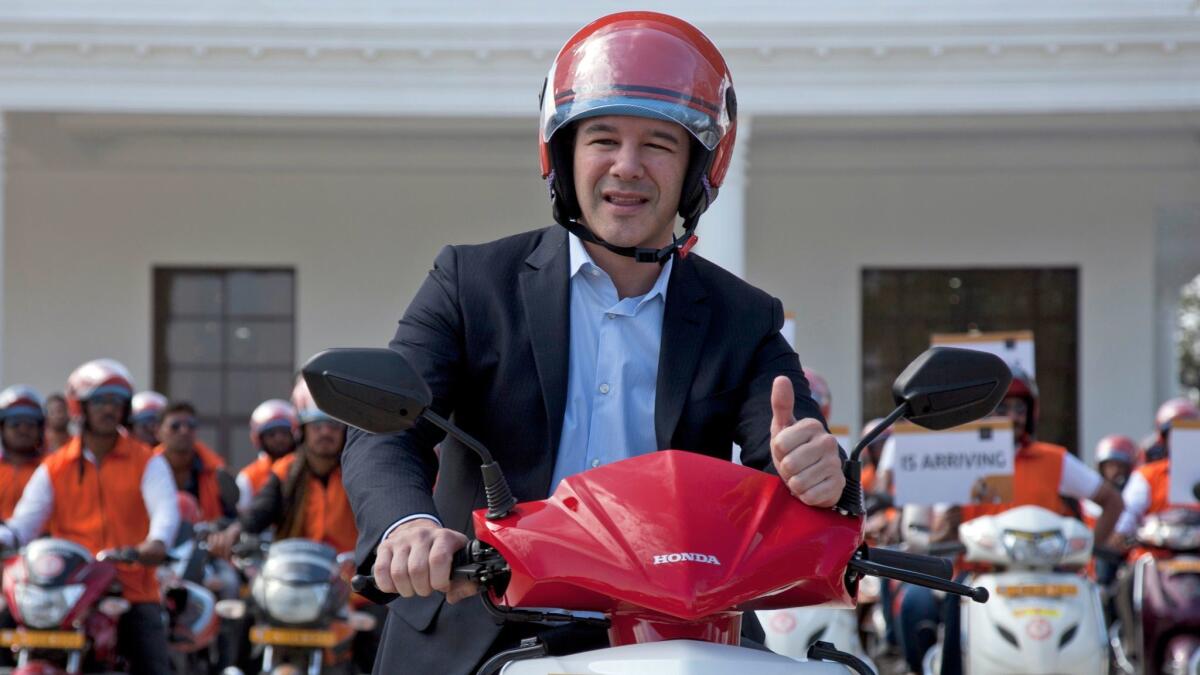Column: For brash Uber, Google’s accusation of theft isn’t even its worst news

It’s hard to know where to start in examining the ways that Uber Chief Executive Travis Kalanick blew it during his painfully documented confrontation with an Uber driver on Feb. 5 over falling fares. But let’s try.
First, Kalanick lost his cool. He was dumb enough to do so in full view of driver Fawzi Kamel’s dashcam, the video of which shortly ended up in the hands of Bloomberg. He displayed absolutely no awareness of the plight of drivers like Kamel, who have invested heavily in vehicles to serve Uber users and been squeezed mercilessly by Uber’s fare policies. He didn’t show the sensitivity to hear out a driver who has plainly been serving the company a lot longer than the average Uber driver, nearly half of whom leave the service within a year. Uttering an expletive, he blamed Kamel for his own problems and flounced angrily out of the car.
Finally, and most importantly, Kalanick treated the episode as though it reflected a personal character flaw that can be moderated with self-examination and “leadership help,” which could be anything from a visit to the Dalai Lama to a session with the “Scared Straight” team. “It’s clear this video is a reflection of me,” he said in a message to Uber employees, “— and the criticism we’ve received is a stark reminder that I must fundamentally change as a leader and grow up.”
Some people don’t want to take responsibility…. They blame everything in their life on somebody else.
— Uber CEO Travis Kalanick, to an Uber driver who complained the company’s policies left him bankrupt
Leaving aside whether Kalanick’s confession is sincere, which is doubtful, it doesn’t address the core problems with Uber as an enterprise. These are all of Kalanick’s making, and they can’t be solved with therapy.
They’re also reflected in the raft of setbacks that have bedeviled Uber over the last few weeks. They started with a boycott of the firm after it was perceived to have taken advantage of a taxi drivers’ strike at New York’s JFK airport to protest President Trump’s immigrant ban. That was followed by a devastating picture of a sexual harassment culture at Uber headquarters posted online by a former engineer, Susan Fowler Rigetti. Then there was the blistering accusation aired last week in a lawsuit by a Google subsidiary that Uber has stolen its driverless car technology.
These all stem to some degree from Uber’s corporate strategy and self-image of a company that isn’t shy about breaking rules and regulations and responding truculently when it encounters pushback. Such behavior may be useful when a company is trying to grow rapidly by arbitraging regulatory gaps. But it creates costs.
One is the erosion of public credit and credibility. A company with a genuine reputation for good corporate citizenship will get away with missteps longer than one seen as a hive of insensitive jerks. A mea culpa will be taken more seriously from the CEO of the first company than from Travis Kalanick: Does anyone really believe that “leadership help” will change him or his company, or that the sexist and abusive behavior chronicled by Rigetti is really “against everything Uber stands for and believes in,” as Kalanick stated in a tweet responding to her post?
The most telling moment in the dashcam video came when Kalanick dismissed Kamel’s complaint about the economic challenges he faces as an Uber driver. In many ways, Kamel was right. “You choose to buy everyone a ride,” he told Kalanick, referring to Uber’s fare-cutting, which comes partially out of the drivers’ pockets and partially from Uber’s indulgent venture investors.
Kamel explained that the decline in his take had made it impossible to cover the cost of the town car he purchased to carry Uber customers. “I’m bankrupt because of you,” he told Kalanick. Yet instead of showing some understanding of how Uber’s business model transfers costs and risks from the company to its drivers, Kalanick barked back, “Some people don’t want to take responsibility for their own…. They blame everything in their life on somebody else.”
That lack of understanding won’t be corrected with “leadership help.” Which brings us to the Google lawsuit.
The lawsuit was filed last Thursday in San Francisco federal court by Waymo, a subsidiary of Alphabet Inc. devoted to developing self-driving technology. (Alphabet is Google’s parent company.) Waymo is responsible for those bug-shaped cars and other vehicles testing the technology around Northern California. They’re equipped with sophisticated laser systems that create a 3-D picture of the landscape, allowing the vehicles to navigate around obstacles.
Waymo says that Anthony Levandowski, who was once Google’s driverless-car guru, downloaded 14,000 proprietary company files onto his own computer and absconded with them when he left Google to found his own company in 2016. That company, Otto, was soon acquired by Uber for $680 million. Not long after that, Google says, it discovered that Otto’s technology was largely identical to its own. The lawsuit seeks damages for alleged infringement of three Google patents and an injunction barring Uber from using any of the technology.
Some Silicon Valley observers were struck by the extensive detail in the accusations.
“Normally in a case like this, there’s a lot of innuendo” in the early stages, says Eric Goldman, a patent law expert at Santa Clara University law school. But Waymo specified how and when it alleges Levandowski downloaded the files, the breadth of his alleged theft and efforts to conceal his actions, and how it discovered them — from an email a supplier mistakenly copied to a Waymo employee.

“Google spent a lot of time and money investigating before it filed the lawsuit,” Goldman told me.
Of course, the lawsuit represents just one side of the story. Uber hasn’t yet responded in court. In a statement, the company said it had determined that Waymo’s claims were “a baseless attempt to slow down a competitor.” Uber added, “We look forward to vigorously defending against them in court.”
Another unusual aspect of the case, Goldman says, is that Google is bringing it at all. Intellectual property lawsuits are out of character for Google. Moreover, Google is an investor in Uber with a stake of at least $250 million; a Google executive sat on Uber’s board until just after Uber acquired Otto.
Google hasn’t said much about why this episode should be different from any others, beyond a Waymo blog post that implies it was just too gross an offense to ignore.
“These actions were part of a concerted plan to steal Waymo’s trade secrets and intellectual property,” the post reads. “Given the overwhelming facts ... we have no choice but to defend our investment and development of this unique technology.” Waymo said it had no comment beyond the assertions in the lawsuit.
Goldman conjectures further that “this might be an asset especially valuable to the Google family, something extra important.” If that’s so, it underscores the grand expectations for driverless technology, despite indications that it may be oversold. Google has been among the most enthusiastic developers in the field.
The case may also underscore the weakness of Uber’s claim to a $70-billion valuation in the private venture market. That valuation had been based on the expectation that Uber was poised to radically reform the transportation-for-hire economy by shouldering vehicle-owning taxi companies and individuals out of the way, replacing them with independent drivers using their own cars. If Google is to be believed, Uber now puts such stake in owning its own capital assets that it was willing to pay $680 million for the necessary (allegedly stolen) technology.
Keep up to date with Michael Hiltzik. Follow @hiltzikm on Twitter, see his Facebook page, or email [email protected].
Return to Michael Hiltzik’s blog.
UPDATES:
2:30 p.m., March 1: This column has been updated with additional analysis.
8:13 a.m., March 1: This column has been updated with a reference to a video of Uber CEO Travis Kalanick arguing with an Uber driver.
This article was originally published Feb. 27.



